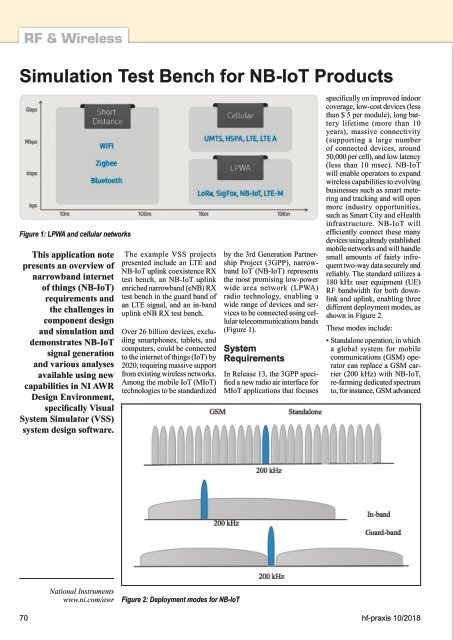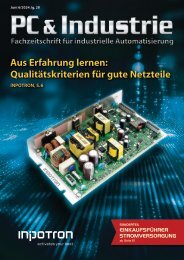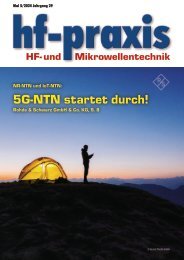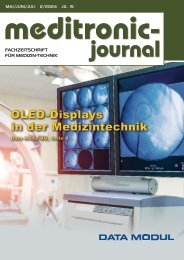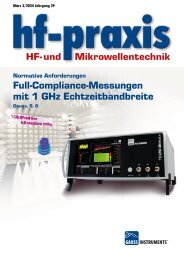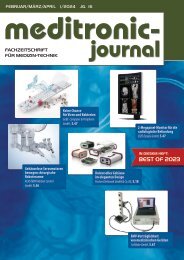10-2018
Fachzeitschrift für Hochfrequenz- und Mikrowellentechnik
Fachzeitschrift für Hochfrequenz- und Mikrowellentechnik
Erfolgreiche ePaper selbst erstellen
Machen Sie aus Ihren PDF Publikationen ein blätterbares Flipbook mit unserer einzigartigen Google optimierten e-Paper Software.
RF & Wireless<br />
Simulation Test Bench for NB-IoT Products<br />
Figure 1: LPWA and cellular networks<br />
This application note<br />
presents an overview of<br />
narrowband internet<br />
of things (NB-IoT)<br />
requirements and<br />
the challenges in<br />
component design<br />
and simulation and<br />
demonstrates NB-IoT<br />
signal generation<br />
and various analyses<br />
available using new<br />
capabilities in NI AWR<br />
Design Environment,<br />
specifically Visual<br />
System Simulator (VSS)<br />
system design software.<br />
The example VSS projects<br />
presented include an LTE and<br />
NB-IoT uplink coexistence RX<br />
test bench, an NB-IoT uplink<br />
enriched narrowband (eNB) RX<br />
test bench in the guard band of<br />
an LTE signal, and an in-band<br />
uplink eNB RX test bench.<br />
Over 26 billion devices, excluding<br />
smartphones, tablets, and<br />
computers, could be connected<br />
to the internet of things (IoT) by<br />
2020, requiring massive support<br />
from existing wireless networks.<br />
Among the mobile IoT (MIoT)<br />
technologies to be standardized<br />
by the 3rd Generation Partnership<br />
Project (3GPP), narrowband<br />
IoT (NB-IoT) represents<br />
the most promising low-power<br />
wide area network (LPWA)<br />
radio technology, enabling a<br />
wide range of devices and services<br />
to be connected using cellular<br />
telecommunications bands<br />
(Figure 1).<br />
System<br />
Requirements<br />
In Release 13, the 3GPP specified<br />
a new radio air interface for<br />
MIoT applications that focuses<br />
specifically on improved indoor<br />
coverage, low-cost devices (less<br />
than $ 5 per module), long battery<br />
lifetime (more than <strong>10</strong><br />
years), massive connectivity<br />
(supporting a large number<br />
of connected devices, around<br />
50,000 per cell), and low latency<br />
(less than <strong>10</strong> msec). NB-IoT<br />
will enable operators to expand<br />
wireless capabilities to evolving<br />
businesses such as smart metering<br />
and tracking and will open<br />
more industry opportunities,<br />
such as Smart City and eHealth<br />
infrastructure. NB-IoT will<br />
efficiently connect these many<br />
devices using already established<br />
mobile networks and will handle<br />
small amounts of fairly infrequent<br />
two-way data securely and<br />
reliably. The standard utilizes a<br />
180 kHz user equipment (UE)<br />
RF bandwidth for both downlink<br />
and uplink, enabling three<br />
different deployment modes, as<br />
shown in Figure 2.<br />
These modes include:<br />
• Standalone operation, in which<br />
a global system for mobile<br />
communications (GSM) operator<br />
can replace a GSM carrier<br />
(200 kHz) with NB-IoT,<br />
re-farming dedicated spectrum<br />
to, for instance, GSM advanced<br />
National Instruments<br />
www.ni.com/awr<br />
Figure 2: Deployment modes for NB-IoT<br />
70 hf-praxis <strong>10</strong>/<strong>2018</strong>


